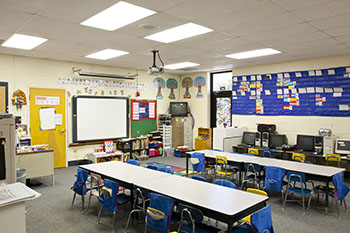Osram Sylvania Gives the Green Light for Sustainability
 DANVERS, Mass. — Complementary lighting of an educational facility can provide a stimulating workspace for students while highlighting positive design choices. With schools giving more focus on operational costs, green lighting choices are proving to be a most cost-effective and environmentally friendly option.
DANVERS, Mass. — Complementary lighting of an educational facility can provide a stimulating workspace for students while highlighting positive design choices. With schools giving more focus on operational costs, green lighting choices are proving to be a most cost-effective and environmentally friendly option.
The lighting of an academic space holds great significance in interior design as well as maintenance and operational budgets.
“Proper lighting has been linked to improved student performance and it can increase alertness and productivity,” said Rick Diehl, business development manager for Osram Sylvania. “By proper lighting I mean higher color rendering versus the old, stark kind of classroom light that is washed of color.”
Proper lighting, according to Diehl, includes more dynamic color rather than the bleak, colorless classroom light used in years past, while also taking advantage of green components offered in modern lighting products.
“Lighting in layers gives you variable levels of ambient lighting but you also are lighting the architectural features and perimeters,” Diehl said.
Osram Sylvania defines the best lighting scenario for educational facilities as one with excellent uniformity, attention to luminance/contrast ratio, lighting well coordinated with architectural design, bright, stimulating color and the incorporation of daylighting with shading.
Daylighting has become a common trend in educational design, Diehl said, which offers a friendly indoor environment with warm light and green features. Daylighting also gives a nod to the design strategies by creating a more sophisticated ambiance and adding to architecturally interesting spaces.
“There is greater use of lighting controls not just to turn lights on and off, but to make greater use of daylight,” Diehl said. “That also has to do with the design of the building itself in that they’re positioned correctly to allow the use of daylight.”
Solid-state lighting and LED lighting are huge trends in university’s that have a commitment to sustainability because of the products’ absence of mercury and long lifetime of the light source, Diehl said.
Other energy-efficient trends of interior lighting that are cost-effective without high expense include automated controls and automated occupancy sensors, according to Diehl.
“When installed in the correct types of spaces [automated occupancy sensors] can yield a very quick payback without a huge investment,” Diehl said.
Simple and inexpensive upgrades in lamping, such as upgrades to the T5 or T8 fluorescent lamp that offer high efficiency electronic ballasts, great color and energy savings, can also be highly cost-effective without breaking the budget.
“They can salvage their existing fixtures and can just replace the components of the fluorescent system and get a very attractive payback,” Diehl said. “And possibly get a rebate from the utility, without a major expense.”
As an example of the many benefits of lamp upgrades, Osram Sylvania produced a case study on the lighting solutions used at three budget conscious Cocke County schools in Newport, Tenn.
By replacing an old fluorescent system of T12 lamps with the energy-efficient T8 lamps, the schools saved $15,151 each year in energy cost savings as well as an additional $15,000 saved in maintenance costs. The new installations will also avert the equivalent of approximately 238,454 pounds of carbon dioxide emissions annually and provide an added 189,389 kilowatt hours each year.
Utilizing 686 pre-assembled fluorescent retrofit kits, containing Sylvania Octron 800 Ecologic lamps and Quicktronic QHE T8 instant Start Universal Voltage ballasts, from Energy Solutions International, the space was transformed to provide excellent lighting while creating a more resourceful system.
Lighting is also developing to fit the needs of tech-based learning, Diehl said. The lighting of a classroom today now takes into account all technological aspects
“The space needs to be adaptable to various audio visual equipment that is now being used,” Diehl said. “Lighting that has improved color and more dimension and adds to the aesthetics of the space as well as is functional with all the other equipment.”
Amounting for 30 percent of total electric costs, lighting choices that provide the best light for the least amount of energy can serious savings in operating costs.
“Light sources that are being used now, whether its long life fluorescent sources, which now can operate up to 80,000 hours, or a LED source, many of which are 50,000 hour plus, will have a big impact on maintenance costs and replacement costs,” Diehl said.
High sodium lights, which do not provide attractive lighting, or short life lighting sources such as incandescent or halogen are no longer common choices for classroom lighting, Diehl said. However, he added that these lights could still find purpose in educational facilities.
“Those sources still have a use in specific application s where they may be lighting art work or something that is important to the space,” Diehl said. “But for general lighting, those sources aren’t used anymore.”
As education and design evolve, Osram Sylvania will continue to provide educational facilities with innovative lighting solutions to provide the greatest light, for a greater lifetime with a limited environmental impact.
